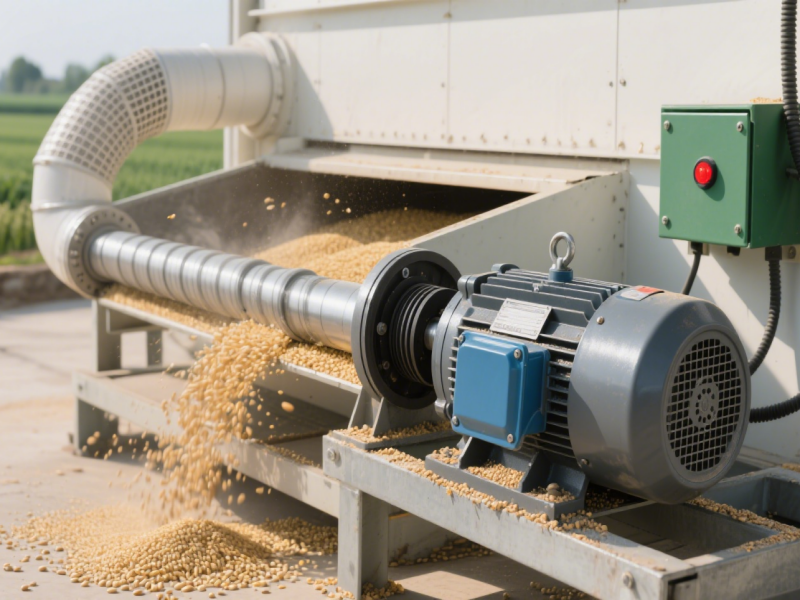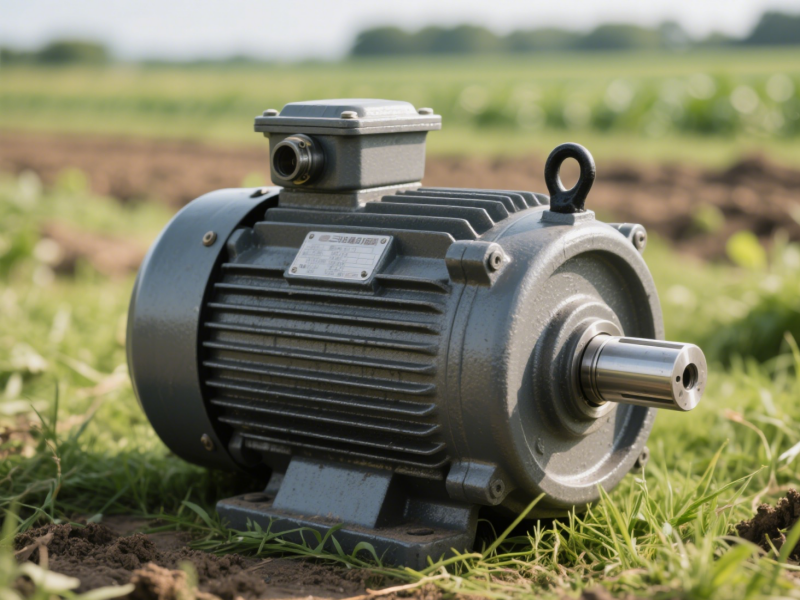Three-phase asynchronous grain dryer agricultural motor
Three-phase asynchronous agricultural motors are the core power components of agricultural grain dryers. Designed specifically for grain drying operations (such as dehydrating crops like wheat, rice, and corn), they are based on the principles of three-phase asynchronous motors, adapted to three-phase power grids, and optimized for the specific needs of agricultural applications. Their core function is to drive key components of the dryer, including the fan, conveyor belt, agitator shaft, and grain discharge mechanism. This ensures hot air circulation, uniform grain rotation, and conveying during the drying process, ultimately achieving target moisture levels.
Core Features: Key Designs Suitable for Agricultural Drying Applications
Agricultural grain dryers typically operate in environments characterized by high dust (grain debris), high humidity (high moisture content of grain before drying), large voltage fluctuations (due to rural power grids), and long continuous operating times (24-hour operation during the harvest season). Therefore, the motor must possess the following targeted designs:
| Feature Classification | Specific requirements | Function Description |
| Protection level | At least IP54 (dust + splash proof), with some high-end models reaching IP55 | Prevent grain dust from entering the motor and causing winding short circuit, while also protecting against moisture and rain splashing in fields/warehouses. |
| Insulation grade | Class F (maximum temperature rise allowed: 155°C) or Class H (maximum temperature rise allowed: 180°C) | When the dryer is running, the hot air temperature is usually 40-80℃, and the motor itself will also generate heat. The high insulation grade can prevent the insulation layer from aging and burning. |
| Overload capacity | Can run continuously for more than 30 minutes at 1.2 times the rated load | The amount of grain may fluctuate during the drying process (e.g. uneven feeding), and the overload capacity prevents the motor from tripping and shutting down due to short-term load increases. |
| Voltage adaptability | Can operate stably within the rated voltage ±10% range (e.g. 380V motor adapts to 342-418V voltage) | To cope with voltage fluctuations in rural power grids, avoid motor speed drop and insufficient output due to low voltage, or winding burnout due to high voltage. |
| Thermal Design | External heat dissipation ribs + axial fan (forced air cooling), some models use “dust-proof heat dissipation cover” | Quickly remove the heat from the motor while preventing dust from blocking the heat dissipation channel (dust accumulation will cause the motor to overheat). |
| Structural strength | Cast iron housing (instead of ordinary aluminum alloy), bearings use sealed deep groove ball bearings (such as 6205-2RS) | To withstand the impact of transporting/installing agricultural equipment, sealed bearings can prevent the ingress of dust and grain debris, extending bearing life. |
Key Points for Grain Dryer Compatibility: The Core of Model Selection
When selecting a motor, consider the dryer’s processing capacity, drying method (co-current, counter-current, or cross-flow), and drive component type to avoid wasting energy or causing motor burnout due to overload.
Power Matching: Determined Based on Dryer Capacity
The dryer’s “capacity” (e.g., 1, 5, or 10 tons of grain per hour) directly determines the motor power. The power of the drive motors for different components varies significantly:
The fan motor: This is the core load, ensuring sufficient air volume (to ensure even penetration of the hot air through the grain layer). Its power typically accounts for 60%-80% of the total power.
For example, a 5-ton/hour downstream dryer would have a fan motor power of approximately 3-5.5kW; a 10-ton/hour cross-flow dryer would have a fan motor power of approximately 7.5-11kW.
The conveyor/mixer motor: This drives the conveyor belt (feeding/discharging grain) and the agitator shaft (preventing grain clumping). It carries a smaller load and typically has a power of 0.75-2.2kW. Total power reference: Small dryers (≤3 tons/hour) have a total motor power of approximately 4-7kW; medium-sized dryers (5-15 tons/hour) have a total motor power of approximately 10-20kW; large dryers (≥20 tons/hour) require more than 22kW, or even a combination of multiple motors.
2. Speed Matching: Adapting to Component Operating Requirements
The rated speed of the three-phase asynchronous motor (e.g., 1450 rpm, 2900 rpm, corresponding to 4-pole and 2-pole motors) must match the speed requirements of the dryer components. This is typically achieved through a reduction mechanism (e.g., gearbox, pulley):
The fan requires a high speed (e.g., 2900 rpm) to produce high air volume, and a 2-pole motor is typically used.
The conveyor belt/mixer shaft requires a low speed (e.g., 10-50 rpm) to prevent grain damage, and a 4-pole motor (1450 rpm) is typically used in conjunction with a gearbox with a reduction ratio of 1:30-1:150.
3. Mounting Method: Adapt to the Dryer Structure
Agricultural dryers are often compact in design, and the motor mounting method must match the equipment’s designated interfaces. Common types include:
B3 (Horizontal Mount): The motor shaft is horizontally mounted and connected to the fan and reduction gearbox via a coupling or pulley. Suitable for fan drives.
B5 (Flange Mount): The motor is directly secured to the dryer housing via a front flange. This is suitable for driving closely located components such as conveyor belts and agitator shafts, saving space.

Operation and Maintenance: The Key to Extending Motor Life
Failures in agricultural motors are often caused by improper maintenance, especially after continuous, high-intensity operation during the dry season. The following precautions should be taken:
1.Daily Use Precautions
Pre-start Inspection: Confirm that the motor terminals are not loose (to prevent overheating due to loose connections), the heat sink is not clogged with dust, and the bearings are not making unusual noises or leaking oil. Observe the current during startup (the no-load current is approximately 30%-50% of the rated current. If overloaded, the machine should be shut down to check for grain blockage).
Avoid Frequent Starting and Stopping: The motor’s starting current is 5-7 times the rated current. Frequent starting and stopping will accelerate winding aging. It is recommended to maintain continuous operation during drying operations (unless equipment cleaning is required).
Voltage Monitoring: If the rural power grid experiences significant fluctuations, it is recommended to use a 10-30kVA three-phase voltage stabilizer to prevent motor stalling when the voltage drops below 340V (this causes a sudden increase in current, which can easily burn the windings).
2. Regular Maintenance (Must Perform After the Dry Season Ends)
Cleaning and Dust Removal: Use compressed air (pressure ≤ 0.5 MPa) to blow away grain dust from the motor interior (requires removing the end covers), heat dissipation ribs, and terminal box. This prevents moisture absorption by dust, which can cause a decrease in insulation resistance. (If the insulation resistance is below 0.5 MΩ, drying is required.)
Bearing Lubrication: Remove the bearing end covers, clean out any old grease (such as calcium-based grease), and add new high-temperature grease (such as lithium-based grease, filling 1/2-2/3 of the bearing internal space) to prevent bearing wear due to oil starvation.
Insulation Testing: Use a 500V megohmmeter to measure the insulation resistance between the motor windings and the housing. If the resistance is below 0.5 MΩ, place the motor in a drying oven (60-80°C) for 4-6 hours to restore insulation performance.
3. Winter Storage
After the dry season, motors should be stored in a dry, well-ventilated warehouse, avoiding exposure to rain, snow, and moisture. Before storage, remove any residual grain from the motor surface, disconnect the power cord, and cover with plastic wrap to prevent dust.




